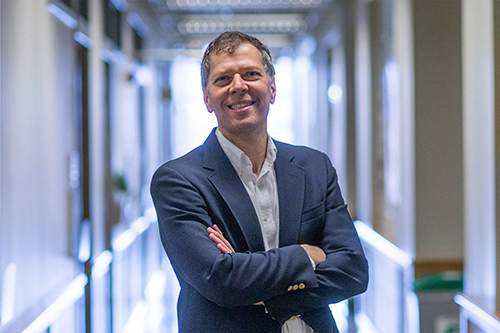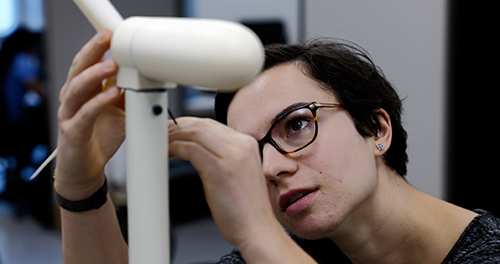|

Go-With-the-Flow Wind Turbine, Conceived by UVA Prof, Completes
Successful Demo

Wind turbine
innovator Eric Loth, who next month steps down as chair of the
Mechanical and Aerospace Engineering Department, is the Rolls-Royce
Commonwealth Professor.
About 15 years ago, University of
Virginia engineering professor Eric Loth started thinking about how he
could help with climate-related dilemmas, which led to his big idea
about improving the design of wind turbines. What if a turbine’s
blades could gracefully bend when subjected to high winds, morphing
with the weather conditions like palm trees do during a hurricane?
After all, it’s the blustery winds at the coast where the greatest
energy opportunities lie.
Loth continued to refine the idea. Now,
having completed a successful demonstration of his 10-story tall
Segmented Ultralight Morphing Rotor, he is another step closer to
making the turbine a reality – one that could provide massive amounts
of clean wind energy for the world.
As a Department of Energy project, now
wrapping up, SUMR has shown that its highly flexible blades and
control system not only work, but that they can be adapted to an
extreme-scale, 25-megawatt power-generating system, which would be a
record in terms of size.
Last month for the first time, Loth and
partners publicly shared evidence of their successful testing at an
annual international meeting in the Netherlands.
“I think that the project has gone really
well,” Loth said of the six-year study, conducted under the DOE’s
Advanced Research Projects Agency.
That may be an understatement. His
turbine, in fact, operated nonstop for two years, including surviving
an unexpected 110-mph gust and a bomb cyclone.
SUMR now appears to be a leading design
in the international race to optimize offshore wind power.
Loth’s
Personal Challenge
Given the billions of
dollars required to develop wind farms, investors want
turbines that can last their full potential lifespans,
about 25 years, while maximizing energy production at a
low cost. One way to do that is by using the longest
blades feasible in the strongest winds possible.
But traditional wind
turbines have had a problem: The bigger the blades get,
the more likely they are to strike the tower supporting
them, especially in high winds.
The personal challenge for
Loth was, essentially, go big or go home.
He went big, with rotors
the size of a football field. Then he went to the
renowned National Wind Technology Center in the
mountains near Boulder, Colorado, where a
multi-institutional research team put them to the test.
UVA partnered with the
University of Texas at Dallas, the University of
Colorado, the Colorado School of Mines, the University
of Illinois and Sandia National Labs. Together, these
institutions took the concept from paper and computer
models to fabrication and execution of the 20%-scale
demonstrator.
The biggest wind turbines
currently being demonstrated or in use at the so-called
“extreme scale” typically produce around 15 or 16
megawatts of power, Loth said, although European
engineers are working on a 22-megawatt design, he added.
At 25 megawatts, SUMR would
be taller than the Eiffel Tower, which is just over
1,000 feet tall.
While an increase to 25
megawatts is a significant step, a jump to 50 megawatts
would be an industry-changing leap forward. And Loth
said an upcoming journal publication by the team will
show that such a design is possible as well.
A turbine that size could
reduce the cost of reaping energy by as much as 20%.

Juliet Simpson, who has worked on
Loth’s SUMR wind turbine project, holds the latest model. (Photo by
Chris Tyree)
Bigger
(and Lighter) Is Better
Loth, who next month steps
down as chair of the Mechanical and Aerospace
Engineering Department, is a Rolls-Royce Commonwealth
Professor and also director of UVA’s Fluids Research
Innovation Lab. He illuminated SUMR’s advantages as
compared to other wind turbines. (And for the record, he
said, it’s pronounced “summer” – not that he would ever
dispute anyone who said it differently.)
SUMR’s secret is a
patented, aero-elastically flexible downwind design.
“Typical turbines are upwind,” Loth said. “We flip the
script and place them downwind.”
Doing so lightens the load
and permits their longer length, as does the
construction of the blades themselves, which are built
in segments and hinged. This reduces the mass of the
rotor relative to the power it can generate.
“Saving system mass saves
money,” Loth said, quoting an aerospace engineering
truism.
However, a downwind
orientation has traditionally caused some problems –
namely noise, wind flow obstruction issues (due to the
closeness of the blades to the tower, which is upwind)
and electronic-controlling issues.
SUMR has overcome all three
concerns, Loth said.
“In terms of noise, our
demonstrator turbine turns out to be very quiet,” he
said. “And we designed the blades to be far enough
apart, so we got rid of the tower-shadow effect. It also
has more intelligent control systems. The software is
levels above what we could do 10 or 20 years ago.”
Loth said the project had
to be scaled down to fit within the Department of
Energy’s $6 million project budget. Sizing up, he noted,
is just a matter of careful extrapolation.
The Wave
of the Future
Given the size of the
turbines, their ultimate rollout in perhaps a decade or
more won’t be in your backyard, but more likely about 25
miles out to sea. There, the turbines would be less
visible to coastal residents and vacationers, and mostly
out of the path of migratory birds, which tend to hug
the coastline during their travels.
“I think that’s going to
happen for sure,” Loth said of U.S. widescale offshore
wind farming, which he expects to see span the Eastern
coastline from North Carolina to Massachusetts.
Dominion Energy is
currently endeavoring to build a large offshore wind
power project in the United States, off Virginia Beach.
SUMR is one example of the
type of projects UVA is encouraging through its
Grand Challenges Research Investments,
which are meant to leverage the capacity for the
University’s brightest minds to innovate solutions to
some of the biggest problems that confront the world.
UVA announced recently it will apply
$60 million toward the development of
clean-energy research and other measures to
promote environmental resilience and sustainability.
Loth joined the UVA faculty
in 2010. In 2015,
Popular Science named him one of
its 12 “Brilliant Minds Behind The New Energy
Revolution” for his promising turbine design.
Then and now, he gives
ample credit to his partners, who have helped him solve
problems and publish papers that have moved the project
forward. Current or recent UVA doctoral students who
worked on the demonstration project include Chao “Chris”
Qin, now a UVA research scientist, and Vanessa Awate,
Michael Jeong, Meghan Kaminski, Carlos Noyes and Juliet
Simpson.
“Like so many others, we
want to do whatever we can to save the planet, and we
are excited to do so with wind,” Loth said.
Loth first worked on wind
turbine projects as an undergraduate in aerospace
engineering at West Virginia University nearly 40 years
ago. His graduate degrees are in aerospace engineering
as well. He earned his master’s from Pennsylvania State
University and his doctorate from the University of
Michigan.
But wind left his life as
he worked on other types of engineering projects, not
only for major universities, but for the Naval Research
Laboratory in Washington, D.C., and other employers. He
has developed jet propulsion systems, even spacecraft
nozzles. He holds several U.S. patents.
Like a turbine, though, his
career has circled back. SUMR could be the innovation of
his that changes the world, although Loth remains modest
about the possibility.

Green Play Ammonia™, Yielder® NFuel Energy.
Spokane, Washington. 99212
www.exactrix.com
509 995 1879 cell, Pacific.
exactrix@exactrix.com
|



